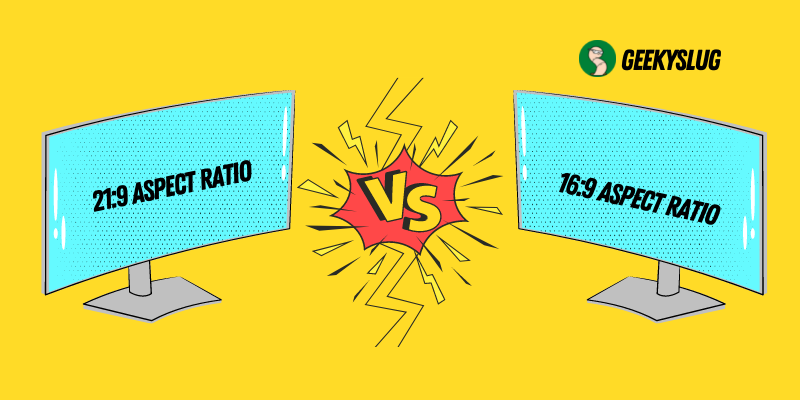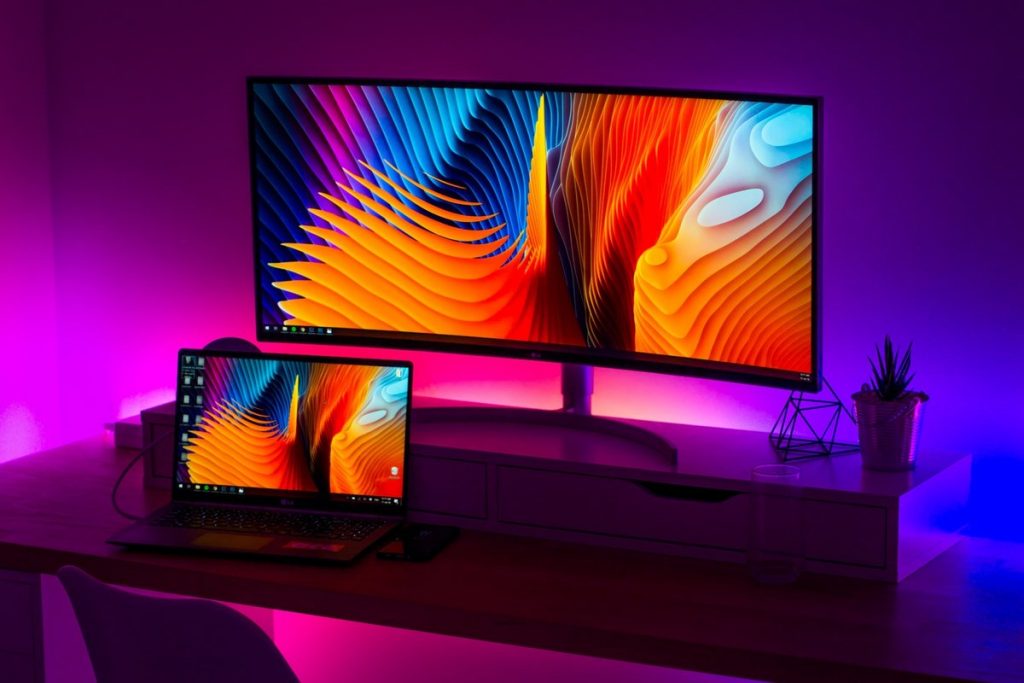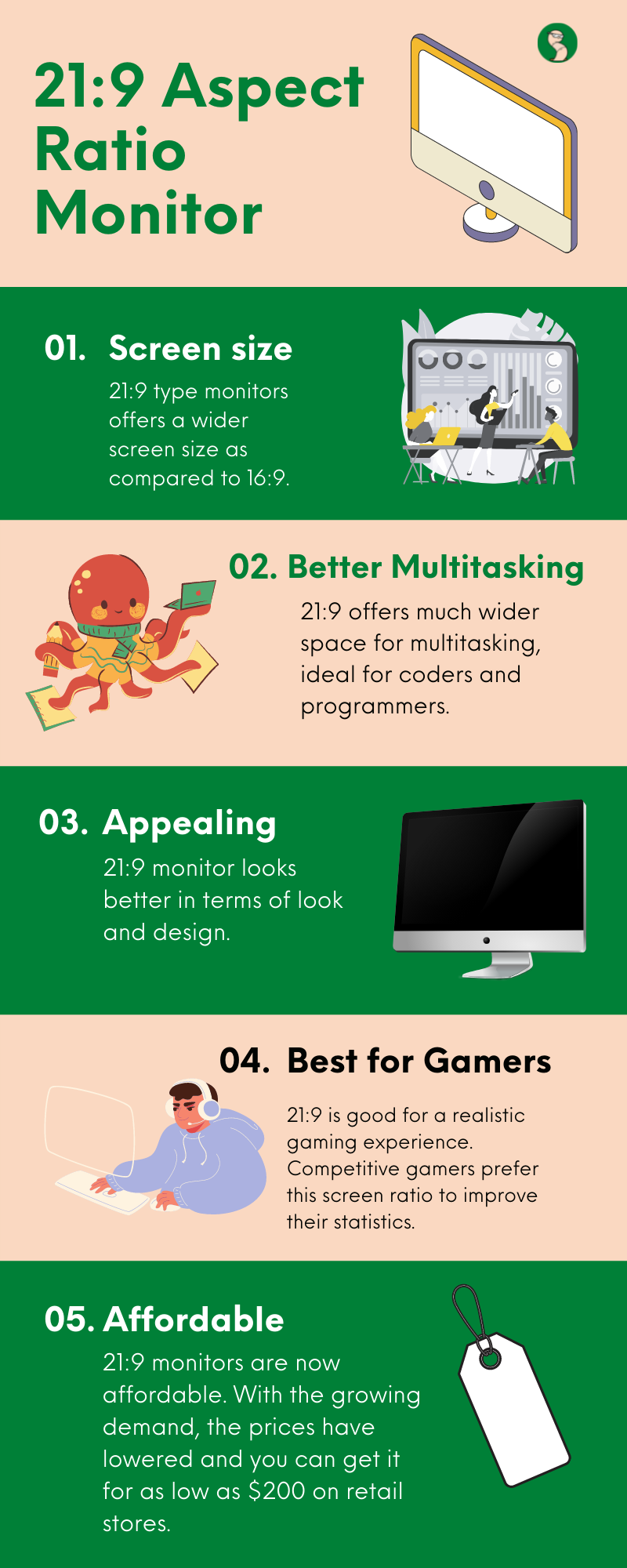21:9 vs 16:9: Ultimate Comparison

Geekyslug is supported by its readers. We independently analyze, test, review, and recommend the latest tech products—learn more about our process. When you buy something through our links, we may earn a commission.
Shifting towards the virtual simulation, looking out of the window to see the world has now become a bit different from what it was before. Now the window has transitioned, and it has become a screen.
Typically a 16:9 screen from which we get a view of the virtual world. While getting that screen, we usually go for the one with an excellent refresh rate, high resolution, sleek design, and mounting, etc.
But what if I told you that a window bigger than the 16:9 ratio? Imagine how much difference it would be in 21:9 vs 16:9? Well, we are here to discuss this very topic today.
Usually, buyers are uninformed of the 21:9 aspect ratio because most prominent displays available today have a 16:9 aspect ratio. However, if you’re unaware of ultrawide’s growing popularity, you could be missing out on a game-changing opportunity.
What is Ultrawide resolution?
Ultra-widescreen, sometimes known as “21:9,” is a word that refers to widescreen resolutions with an aspect ratio of about greater than 2:1.
Whenever you are searching for an ultrawide monitor, you’ll notice “21:9,” but this is just a promotional phrase that caught on after companies realised that the similarities. Putting 21:9 vs 16:9 makes it easier for customers to comprehend.
Depending on the size of the panel, ultra-wide monitors exhibit at either 2560×1080 or 3440×1440 pixels. With an increased pixel resolution, you can accommodate more applications, games, software, or movies on the same computer without swapping between them all the time.
What is the difference between the 16:9 and 21:9 aspect ratios?
Additional pixels are stretched out horizontally on ultrawide monitors. A 21:9 monitor with a resolution of 2560 x 1080 would be equivalent to a 16:9 monitor with a resolution of 1920 x 1080.
For a 2K or WQHD monitor, the resolution is 2560 x 1440, which is 3440 x 1440 on a comparable 21:9 monitor. To cut a long tale short, both resolutions contain significantly more horizontally dispersed pixels.
This can get even wilder with a resolution close to 5K in a 21:9 aspect ratio, but that’s not really feasible for the normal individual.
Because of the increase in pixels horizontally, 21:9 can provide a real benefit for games with good optimisation. Nevertheless, many competitive games do not support 21:9 aspect ratios.
Therefore, you may be forced with black lines on the sides in such games. One more thing worth noting is that 21:9 monitors are more complex to use than 16:9 monitors.
21:9 vs 16:9 – Which one is the best for gaming?
Throughout most computer games, the 21:9 aspect ratio provides a ‘Field Of Vision’ (FOV) edge. The number of players uses Hor+ scaling, which implies that the vertical component of the FOV remains constant when the aspect ratio expands, but the horizontal component grows.
It’s not just about giving better visuals in video games when it comes to 21:9. They are convenient in productivity jobs since you have extra horizontal room to operate with.
The number of monitors with a refresh rate of 100Hz or even more with a 21:9 aspect ratio is growing. If you already have the graphical capacity to run these monitors, you may have a significant competitive advantage.
You can even multitask thanks to the two or more full-size open windows for optimal productivity, varying according to the size and resolution. The additional screen space is particularly beneficial in video processing, as it gives you more room to operate.
If you go through the comprehensive performance test between the 16:9 vs 21:9, it is evident that you will get a faster refresh rate; the 16:9 display is a superior and less expensive alternative for multiplayer games. Still, for single-player games, 21:9 is unquestionably superior.
Why is 16:9 better?
The 16:9 aspect ratio is extremely popular, which means it is also the most widely accepted. Furthermore, a 16:9 monitor will invariably provide superior value and, in some cases, capabilities not accessible on more cost 21:9 panels.
One of the significant reasons that 16:9 is better in the 16:9 vs 21:9 aspect ratio battle is because many competitive games do not support the 21:9 ratio.
The 21:9 is undoubtedly superior when it gets to graphics and resolution. But there is a lot more to be considered than that when we talk about gaming.
The more expansive screen space of 21:9 is a double edge sword which, on the one hand, provides you with an ultra-wide view and gives you a bigger vision. However, when it comes to competitive gaming platforms, this 21:9 seems to be losing in the race between 21:9 vs 16:9.
These competitive gaming platforms have guidelines that ideally allow only a 16:9 aspect ratio. Therefore if you have a 21:9 aspect ratio screen, then you will get the black bars on your screen
Pros & Cons of Using 21:9 Aspect Ratio Monitor
[i2pc show_title=”false” title=”Pros & Cons” show_button=”false” pros_title=”Pros” cons_title=”Cons” ][i2pros]Ultrawide monitor gives you extra screen spaceMore space for multitasking
Sleek look
21:9 provides you with extra ports
Outstanding for the gaming experience
[/i2pros][i2cons]Expensive as compared to 16:9
Non-standard resolution
More power-consuming to maintain the pixel resolution. [/i2cons][/i2pc]
Pros & Cons of Using 16:9 Aspect Ratio Monitor
[i2pc show_title=”false” title=”Pros & Cons” show_button=”false” pros_title=”Pros” cons_title=”Cons” ][i2pros]More vertical space while using windowsNo black bars necessary on the screen
High resolution without excess power consumption
Ideal for competitive gaming
Excellent choice for multi-monitor set-up.
[/i2pros][i2cons]Less screen space than 21:9
It doesn’t give you a broader picture like 21:9[/i2cons][/i2pc]
Final Words
The battle between the 21:9 vs 16:9 aspect ratio for a monitor has been a long one. In the above sections, it can be seen clearly that both the 21:9 as well as the 16:9 aspect ratios have their own benefits and disadvantages.
While the 21:9 aspect ratio offers us a broader angle, it is not suitable for competitive or multiplayer gaming, and you get the black bars on your screen.
While 16:9 consumes less power to manage the high resolution and refresh rate, it is also ideal for gaming. It does not permit you to have a wider perspective.
To sum up, I would say that 16:9 is an ideal pick for regular work and gaming, but if you are fond of the broader perspectives and are equipped with a high power supply to keep up with the graphics. 21:9 is always a better choice.
FAQs
Are there more movies 16:9 or 21:9?
Most of the movies are set to the 16:9 aspect ratio by default. However, there are a few movies that are set to the 21:9 aspect ratio.
Is a 21:9 aspect ratio good?
Yes, it is, and the broader field of view serves as a massive benefit for the 21:9 aspect ratio.
Is 2560×1440 ultra-wide?
Yes, both the 2560×1440 and 3440×1440 are considered ultra-wide resolutions.
Is 1920×1080 the same as 16:9?
The answer is yes. The 1920×1080 is a 16:9 aspect ratio and mostly all the cameras, mobile phones, etc. Are set to 16:9.
Related Guides
Mohit Batra
A Tech Enthusiast who loves to spend his time exploring new gadgets, playing games, and writing about his passion for technology. My relentless curiosity drives me to explore the limitless possibilities that technology offers and help people troubleshoot their tech issues.




![dns probe finished no internet error [permanent solution]](https://geekyslug.com/wp-content/uploads/2021/10/DNS_Probe_Finished_No_Internet-Error-Permanent-Solution.png)



